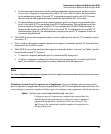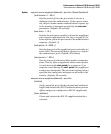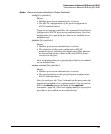
63
Enhancements in Release F.05.05 through F.05.70
Enhancements in Release F.05.05 through F.05.60
Viewing 802.1X Open VLAN Mode Status
You can examine the switch’s current VLAN status by using the show port-access authenticator and
show vlan < vlan-id > commands as illustrated in this section. Figure 14 shows an example of show
port-access authenticator output, and table 4 describes the data that this command displays. Figure
15 shows related VLAN data that can help you to see how the switch is using statically configured
VLANs to support 802.1X operation.
Figure 14. Example Showing Ports Configured for Open VLAN Mode
Thus, in the show port-access authenticator output:
■ When the Auth VLAN ID is configured and matches the Current VLAN ID in the above command
output, an authenticated client is connected to the port. (This assumes the port is not a
statically configured member of the VLAN you are using for Auth VLAN.)
■ When the Unauth VLAN ID is configured and matches the Current VLAN ID in the above
command output, an unauthenticated client is connected to the port. (This assumes the port
is not a statically configured member of the VLAN you are using for Unauth VLAN.)
An Unauth VLAN ID appearing in the
Current VLAN ID column for the same port
indicates an unauthenticated client is
connected to this port.
(Assumes that the port is not a statically
configured member of VLAN 100.)
Items 1 through 3 indicate that an authenticated client is
connected to port 2:
1.Open in the Status column
2.Authorized in the Authenticator State column
3.The Auth VLAN ID (101) is also in the Current VLAN ID
column. (This assumes that the port is not a statically
configured member of VLAN 101.)
1
2
3
4
5
4.A “0” in the row for port 3 indicates there is no
Authorized VLAN configured for port 3.
5.“No PVID” means there is currently no untagged
VLAN membership on port 4.


















